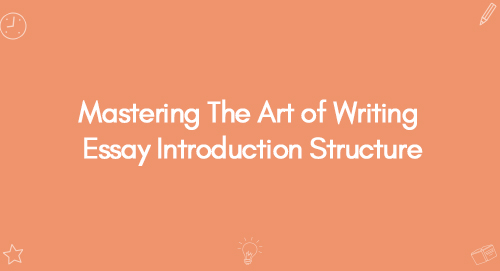How to Write a Descriptive Essay?
How to Write a Descriptive Essay?

How to Write a Comparative Essay? Best Practices and Examples
October 14, 2022
How to Write a History Essay | Tips And Tricks
October 18, 2022Writing a descriptive essay can be a rewarding experience, but it can also be challenging. If you are a student looking for help with your descriptive essay or trying to get your essay written, this blog post is for you. In the following paragraphs, we will go over the steps to writing a descriptive essay.
A descriptive essay describes a person, thing, place, or event. The objective of a descriptive essay is to give your reader a clear image of your subject. While writing a descriptive essay, remember that you are not just writing to tell a story; you are also writing to provide your reader with a sensory experience.
Let's start learning how to write a descriptive essay that scores an A grade.
How to write a descriptive essay
Follow these steps on how to write a descriptive essay if you want to ace your next essay exam
Brainstorming
Let your brain muscles flex. Think about what you want to describe and why. It might be helpful to list the things you want to describe.
For instance, if you are writing about your Grandmother's house, you may want to list some of the following details: her cosy kitchen with all its gadgets; the way she arranges her home; what kind of furniture she likes; how many bedrooms there are; what family pictures adorn the walls; any unique knick-knacks that might have belonged to your great-grandparents, etc.
Once you have brainstormed and have a list of ideas, choose one thing from your list, and start developing it into an essay.
Use sensory details
When describing your topic, use words that engage the five senses. Check out these descriptive essay examples below to get an idea.
For example, rather than saying, "I went for a walk in the park", say, "I strolled through the park, listening to the birds chirp and admiring the freshly cut grass," or
"The flowers in grandma's garden are beautiful" try instead ", The fragrance of grandma's flowers filled the air, and I could see all sorts of colors; deep purples, vibrant oranges, soft pinks", etc.
It will help your reader feel like they are right there with you.
Be original
Try not to use too many cliches in your descriptions.
Clichés are phrases that have been used so often they have become trite or overly familiar such as "nice as pie" or "a diamond in the rough." Mix them up if you must use them, so they don't become annoying. Here is another phrase from a descriptive essay example.
For example: rather than saying, "He was as mad as a hornet", try instead ", He was angry enough to sting." Get creative with your word choices!
Use similes and metaphors.
These two literary devices can add interest to your descriptions by comparing two unlike things using like or as. For example, The room was as dark as a coffin, or His eyes shone like diamonds. A metaphor is comparing two different things without using like or as.
For example, Her laugh was music to his ears. Get creative with these too! Make sure that whatever comparisons you make help describe your topic rather than just taking up space with empty words.
Free Premier Essay Writing Topics
Essay Writing is an essential part of academics which presents the ideas, arguments, opinions, or positions of the writer regarding the topic. The writer supports his claims using facts, evidence, or survey studies.
- Clear presentation or understanding of the type of essay
- An appealing introduction with an unambiguous thesis statement
- A well-defined structure of body paragraphs supporting the thesis
A prospective conclusion with an optimistic tone
How to start a descriptive essay
The first question that pops up while learning how to start a descriptive essay is how to start one.
A descriptive essay is a type that, as the name suggests, depicts a particular setting, individual, feeling, or event. Students can think creatively when reading this genre. Describe all the thoughts and feelings associated with your issue if you wish to engage the reader more deeply. And if you're having trouble connecting with the reader, keep trying!
A good outline must be created before the writer can compose a powerful descriptive essay. The phases in the pre-writing or planning process of a successful descriptive essay are as follows:
To ultimately start your descriptive essay writing process, stick to the procedures listed below:
Select topic
Lecturers often give the topic for a descriptive essay. However, if you have a choice of topics, you have a fantastic chance to choose something you are knowledgeable about.
The focus of a descriptive essay is often one thing, such as a person, an occasion, or a place. It is the reader's responsibility to offer a thorough description of the subject while writing. A writer should have it in mind while selecting a topic.
Thesis Statement
Create a compelling thesis statement following the brainstorming session. Because it will be a significant section of the essay, it is a highly important component of the overall.
Your thesis statement should be written to provide the whole essay's main idea and lay out the framework for the subject. It must be persuasive enough to inform the reader of what to anticipate in the body.

Structuring and Organizing
Introduction
The introduction of a descriptive essay provides general information about the topic. It should also include a thesis statement that provides the main point or argument of the essay.
Body Paragraphs
The body paragraphs of a descriptive essay gives detailed information about the topic. Each paragraph should focus on a specific aspect of the topic and include supporting details such as concrete examples, quotations, or statistics.
Conclusion
A descriptive essay's conclusion should summarise the essay's main points and leave the reader with a lasting impression of the topic. It should not simply restate the thesis but should also include a brief evaluation of the information presented in the body paragraphs.
Language
Descriptive essays should be written in the appropriate language for the audience and purpose. Using first-person pronouns (I, me, my, ours) is often discouraged in academic writing, so it is important to choose objective and precise language.
Tone
The tone of a descriptive essay can vary depending on the audience and purpose. For example, an essay describing a place might be written in a formal or objective tone, while an essay describing a person might be written in a more personal or intimate tone.
Structure
Descriptive essays can be organized in various ways, but they typically follow a standard five-paragraph structure: an introduction, literature review, three body paragraphs, and a conclusion. However, longer essays may need more than five paragraphs to cover the topic adequately.
Formatting
Descriptive essays are typically formatted using MLA or APA style guidelines. However, always confirm with your instructor to ensure you use the correct formatting for your assignment.
Tips for writing an effective essay
- Start by brainstorming ideas for your essay.
- Narrow your topic to a specific subject, such as a person, place, event, or object.
- Write a thesis statement that summarizes the main point of your essay.
- Craft an outline that includes the main points you want to discuss in your essay.
- Write the first draft of your essay, including all the supporting details and evidence you have gathered.
- Edit and revise your essay, making sure that it is transparent and concise.
- Proofread your essay for any grammar or spelling errors.
- Publish or share your essay with your audience
- The essay should include information about the history of the subject.
- The essay should include information about the cultural context of the subject.
Conclusion
We hope you are now up to pace with how to write a descriptive essay, and our descriptive essay examples have inspired you to write a brilliant one. Here is the final advice.
A good descriptive essay should transport your reader into the world that you are describing. Using sensory details, carefully chosen metaphors and similes, well-developed characters, strong verbs, and vivid adjectives. You can create a masterfully crafted essay that leaves your reader truly convinced that they have seen what you have described before their eyes!
Contact Premier Essays to learn more or get professional help with your essay.
Related Topics
- Generic nouns
- Specific nouns
- Group nouns
- Individual pronouns
- Mass and discrete nouns
Examples
- Generic nouns
- Specific nouns
- Group nouns
- Individual pronouns
- Mass and discrete nouns
Other
-
Generic nouns
-
Specific nouns
-
Group nouns
-
Individual pronouns
-
Mass and discrete nouns
















